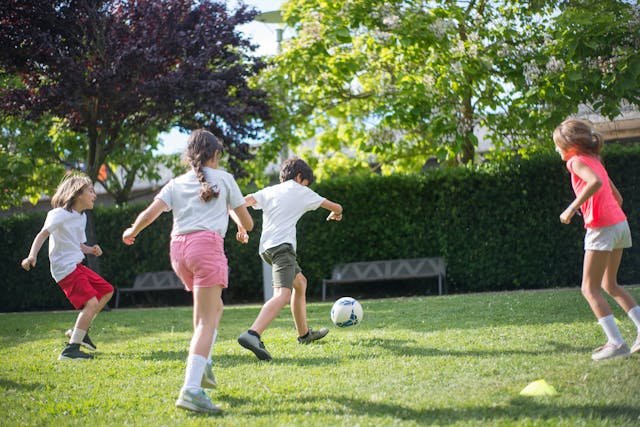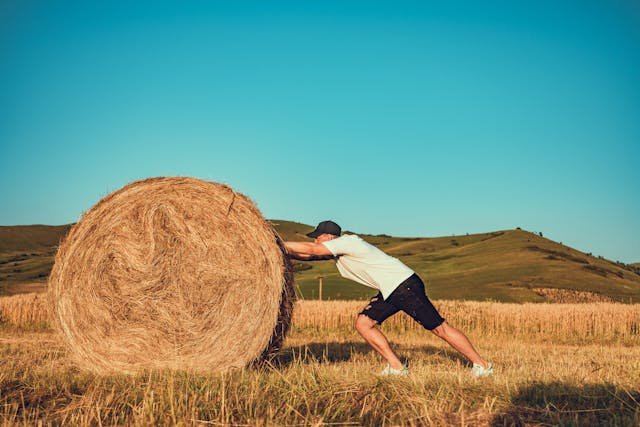Have you ever pushed a toy car and watched it roll across the floor? Or kicked a football and saw it fly into the goal? That invisible “something” that made the toy car move or the ball fly is called force.
Force is one of the first things we notice about the world, even as babies. We push, pull, lift, drop, throw, catch… all of these are moments when force is at work. It is not magic. It is not guesswork. It is something we can understand, explain, and even use to make our lives easier and more fun.
In this guide, we will explore force in the simplest way possible — with clear examples you see every day, tiny experiments you can try at home, and questions that will make you think deeper. You won’t need a lab coat or fancy machines. You will only need your eyes, your hands, your brain, and your curiosity.
By the end of this, you will not just know what force is — you will be able to see it everywhere. And that’s when the real magic of learning begins.
Understanding Force in the Easiest Way
Let’s start simple: Force is a push or a pull.
That’s it. If you remember only one thing from this section, remember this: force is what makes things move, stop, or change direction. You use force every single day without even thinking about it.
If you push a door to open it — that’s force.
If you pull your chair closer to the table — that’s force.
If you throw a ball into the air — you are using force.
Here’s the interesting part: force can do more than just move things. It can also change the shape of something. When you press a sponge and it flattens, you’re using force. When you stretch a rubber band, you’re using force. Even when you squish a pillow, that’s still force.
Two Simple Kinds of Force You See Every Day
Although there are many types of force in science, we can start with two that you already know well without realizing:
- Push – When you move something away from you. For example, pushing a swing, shoving a box, or pressing a button.
- Pull – When you bring something closer to you. For example, pulling open a drawer, dragging a toy, or reeling in a kite.
If you understand these two, you already understand the heart of force. Everything else is just a more detailed version of pushing and pulling.
A Little Home Experiment
Here’s a fun test you can try now:
Take a small ball and place it on the floor. Give it a gentle push with your hand. Watch it roll. Now try pulling it back toward you with a piece of string tied to it. You’ve just used two kinds of force — push and pull — and you didn’t even need a science lab to do it.
If you want to make it even more fun, try changing how hard you push. Push softly, and the ball moves slowly. Push harder, and it rolls faster and farther. This shows us something important: the size of the force matters.
The Size of Force
The size of a force is simply how strong it is. Scientists call it magnitude, but let’s keep it simple and say “strength.” A strong push or pull will make things move faster or farther. A weak push or pull might only make them move a little — or not at all.
Think of when you try to move a heavy sofa. If you push gently, it won’t budge. If you push hard — or get a friend to help — the sofa will move. That’s because heavier objects need more force to get moving.
Force Can Change Direction Too
Force doesn’t only start or stop motion — it can change where something is going. Imagine riding a bicycle and turning the handlebars to the left. That’s you applying a force to change the direction of the bike. If you’ve ever kicked a moving ball from the side, you’ve seen this in action — the ball’s path changes because of the force you applied.
If you can see the world in pushes, pulls, and changes in direction, you are already thinking like a young scientist. And here’s the best part: you can use this knowledge in games, sports, and even solving little problems at home.
Different Types of Forces You Already Know

When scientists study forces, they give them specific names. But you’ve already met most of them in your life — you just didn’t know what to call them. Let’s look at a few.
1. Gravity – The Pull Toward Earth
If you drop a pencil, it falls down. Not sideways. Not up. Always down.
That’s because Earth is pulling it toward itself. This pull is called gravity.
Gravity works on everything — from you, to your toys, to the Moon itself. It’s why we stay on the ground and don’t float away like balloons. If you’ve ever jumped and come back down, you’ve felt gravity in action.
Fun fact: the reason a ball rolls downhill is because gravity is pulling it down the slope. If you want to see gravity at work, drop two different objects — like a crumpled paper and a shoe — and notice that they both fall to the ground (although air might slow the paper a little).
2. Friction – The Force That Slows Things Down
Push a toy car across a smooth floor and it will roll far. Push it across a carpet, and it will stop quickly. Why?
Because of friction — the force that happens when two surfaces rub against each other.
Friction can be helpful or annoying. It slows you down when you slide on grass, but it also keeps your shoes from slipping when you walk. Without friction, we couldn’t write with pencils (the tip needs friction to leave a mark on paper), and cars couldn’t stop when brakes are used.
3. Air Resistance – The Invisible Slowdown
Have you ever stuck your hand out of a moving car window (safely, with an adult driving) and felt the air push against it? That’s air resistance.
It’s like friction, but with air instead of surfaces. Air resistance is why parachutes work, why feathers fall slowly, and why fast runners lean forward — they’re pushing against the air.
4. Muscle Force – The Force from Your Own Body
Every time you pick up your school bag, throw a ball, or wave your hand, you are using muscle force. Your body turns food into energy, and your muscles turn that energy into movement.
It’s one of the first types of force we learn to use as babies — lifting our heads, crawling, walking, climbing. It’s also the force that lets you play sports, dance, and even type on a computer.
5. Magnetic Force – The Pull or Push Without Touching
Magnets are amazing because they can pull or push things without touching them.
If you’ve ever played with fridge magnets, you know they can stick to some metals. Two magnets can even push away from each other if you put the wrong sides together. That’s magnetic force.
Scientists use it in trains, speakers, and even in making electricity. But for kids, magnets are just pure fun to experiment with.
Why Knowing About Forces Matters
You might be wondering — why should I care about all these types of forces?
Because once you understand them, you can use them.
- You can ride your bike better if you know how friction and muscle force work.
- You can kick a football farther if you understand the size of the force you use.
- You can build better paper airplanes if you think about air resistance.
When you understand force, the world becomes like a puzzle you can solve — and you get better at solving it every day.
How Forces Work Together

Forces don’t always act alone. In the real world, there are usually many forces acting on an object at the same time. Sometimes they help each other. Sometimes they cancel each other out. Understanding this is like learning the “team game” of physics.
Balanced Forces
Imagine you’re playing tug-of-war with a friend, and you’re both pulling with the exact same strength in opposite directions. What happens? The rope doesn’t move.
This is called balanced forces. The forces cancel each other out, so nothing changes — no movement, no speed change, no direction change.
You see this in everyday life:
- A book lying on a table — gravity pulls it down, but the table pushes it up with equal force.
- A balloon hanging still in the air indoors — air pushes on all sides equally, so it stays in place.
Unbalanced Forces
Now, what if you pull harder than your friend in tug-of-war? The rope moves toward you. That’s unbalanced forces — one force is stronger than the other, so movement happens.
Real-life examples:
- A football starts rolling when you kick it harder than the friction trying to slow it down.
- A swing moves higher when you push harder than gravity’s pull.
Whenever you see movement start, stop, or change direction, you can be sure there’s an unbalanced force at play.
Tiny Experiments You Can Try at Home
These are safe and fun ways to see forces at work without special equipment.
1. The Tablecloth Trick (Mini Version)
Place a smooth cloth on a table and set a plastic cup (empty) on top. Pull the cloth slowly — the cup will move with it because friction between the cloth and cup is strong enough. Now try pulling it fast — the cup might stay behind because you’ve reduced the time friction has to act. This shows how speed can affect force.
2. The Ramp Race
Get two toy cars and a ramp (you can use a book and a board). Roll one car down the ramp onto a smooth floor and the other onto a carpet. The car on the smooth floor will go farther because there’s less friction slowing it down.
3. The Magnet Chase
Take a magnet and a small metal paper clip. Move the magnet under a piece of cardboard or a table — the clip will follow without you touching it. This shows magnetic force acting through a surface.
4. Push vs. Pull Balloon Game
Blow up a balloon, tie it, and place it on the floor. First, push it gently and watch it roll. Then, tie a string to it and pull it back. You’re seeing the two main types of force in action.
Seeing Forces Everywhere
Once you start noticing these patterns, you’ll see forces in:
- A kite flying in the wind (pull from the string + push from the air).
- A skateboard slowing down (friction from the ground + gravity pulling downhill).
- A swing moving (push from your legs + pull from gravity).
The more you see them, the better you get at predicting what will happen next — just like a scientist.
How Force, Mass, and Motion Are Connected

Think about pushing two things:
- A small empty box.
- A big box full of books.
You’ll notice something right away — the small box moves easily, but the heavy box takes a lot more effort. That’s because the more mass something has, the more force it needs to move.
What Is Mass?
Mass is just how much “stuff” is in an object. Scientists measure it in kilograms, but for now, think of it as weight (even though weight is slightly different — weight is mass plus the pull of gravity). A basketball and a bowling ball might be the same size, but the bowling ball has more mass because it’s heavier.
Newton’s First Law (The Lazy Object Rule)
Sir Isaac Newton, one of the most famous scientists in history, gave us a simple way to think about motion:
Things like to keep doing whatever they’re already doing.
If something is sitting still, it will stay still until a force moves it. If something is moving, it will keep moving until a force stops it.
That’s why a football doesn’t roll forever — friction and gravity slow it down.
That’s why a book doesn’t slide off your desk on its own — no force is acting to move it.
Newton’s Second Law (The Push-Harder Rule)
Newton also explained how force and mass work together:
The bigger the mass, the more force you need to move it.
This is why a child can push a toy truck easily but might struggle to push a real car.
It’s also why athletes train to build more strength — to apply more force when they need it.
Newton’s Third Law (The Equal and Opposite Rule)
This one is a bit like magic, but it’s true:
Every action has an equal and opposite reaction.
If you push on a wall, the wall pushes back on you with the same force (you just don’t notice because the wall doesn’t move).
If you jump off a small boat, you move forward — but the boat moves backward.
When a bird flaps its wings down, the air pushes the bird up.
This rule is everywhere — from swimming to rockets blasting into space.
Why This Matters for Kids
When you understand these three rules, you can predict how things will move. You’ll start to notice:
- Why it’s easier to ride your scooter downhill than uphill.
- Why a bowling ball is harder to throw than a tennis ball.
- Why you can’t run forever without slowing down (your muscles get tired and friction resists you).
And here’s a secret: this is the same science engineers, athletes, and inventors use to design everything from roller coasters to airplanes.
Real-World Uses of Force Kids Can Relate To

Once you start seeing force in action, you can’t “unsee” it. It’s everywhere — in the playground, in your games, in your hobbies, even in the way you open your juice box. Let’s explore.
In Sports
Every sport is basically a game of force.
- Football (Soccer) – When you kick the ball, you’re applying force with your leg. The harder the kick, the faster and farther the ball goes. If you kick from the side, you change its direction. Goalkeepers use force to push the ball away from the goal.
- Basketball – A jump shot uses muscle force to push the ball upward, while gravity pulls it down into the hoop. The perfect shot balances these two forces.
- Tennis – A fast serve is a huge burst of muscle force combined with perfect timing. The strings on the racket add even more force to the ball.
- Swimming – Every time you push water back with your arms, water pushes you forward. That’s Newton’s third law in action.
Knowing how force works helps athletes improve their performance. That’s why coaches talk about timing, technique, and power — they’re all ways of controlling force.
In Playground Fun
The playground is basically a mini science lab.
- Slide – Gravity pulls you down. Friction from the slide surface slows you a little, which is why a smooth metal slide is faster than a rough plastic one.
- Swing – You move higher when you pump your legs, adding muscle force. Once you stop adding force, friction from the air and chains slowly stops you.
- Seesaw – When one side goes down, gravity pulls it, and the other side goes up. Balanced forces keep it still when no one is moving.
Next time you’re playing, try guessing which forces are acting on you — it’s a fun mental challenge.
At Home
Even your daily chores are little force experiments.
- Opening a jar – You use muscle force to twist the lid. Friction between the lid and jar keeps it closed until you apply enough force.
- Pushing a chair – The heavier the chair (more mass), the more force you need.
- Hanging clothes on a line – Gravity pulls them down, but the clothespins use friction to hold them up.
Problem-Solving with Force
Understanding force can actually make you better at solving everyday problems.
- If your toy car won’t roll far, check if friction is too high (dirty wheels or rough surface).
- If your kite won’t fly, maybe the wind (air force) is too weak.
- If your bike is hard to pedal, you might need more muscle force — or maybe the brakes are rubbing and adding extra friction.
Knowing how to spot and adjust forces turns you into a little engineer. You’re not just guessing — you’re thinking like a problem solver.
Fun DIY Experiments to Learn Force at Home

Learning about force isn’t about memorizing boring definitions — it’s about seeing and feeling it in action. These experiments are safe, easy to set up, and use things you probably already have at home. You can do them alone, with a friend, or even challenge your family to join in.
1. The Ramp Speed Test
Purpose: See how gravity and slope work together to change speed.
What You Need:
- A long board, stiff cardboard, or even a baking tray turned upside down.
- A few books or sturdy boxes to raise one end of your ramp.
- A toy car with wheels that roll smoothly.
- A stopwatch (or use a phone timer).
Steps:
- Rest one end of the board on the books to make a slope.
- Place the toy car at the very top, let go, and time how long it takes to roll to the bottom.
- Repeat three times and write down the times to see if they match.
- Now make the ramp steeper by adding more books under one end.
- Test again and compare your times.
What Happens:
The steeper the ramp, the faster gravity pulls the car down. Less steep means slower movement.
Extra Challenge: Try putting different objects (like a marble or a small block) on the ramp. Do they move faster or slower than the car?
2. The Balloon Rocket
Purpose: Learn how air can push objects forward (Newton’s third law).
What You Need:
- A balloon (long ones work best, but round ones are fine).
- A long piece of string (about 3–5 meters).
- A drinking straw.
- Tape.
- Two chairs or other objects to tie the string between.
Steps:
- Thread the string through the straw.
- Tie each end of the string to the chairs so the string is stretched tight.
- Blow up the balloon (don’t tie it), and hold the end closed.
- Tape the balloon to the straw so it’s lined up with the string.
- Let go and watch it zoom!
What Happens:
Air rushing out of the balloon pushes the balloon in the opposite direction — that’s the equal and opposite reaction Newton talked about.
Extra Challenge: Change the size of the balloon or angle of the string to see if it goes faster or slower.
3. The Friction Test
Purpose: Compare how friction changes movement.
What You Need:
- A small toy car or box.
- Three different surfaces (smooth floor, carpet, towel).
- Measuring tape or ruler.
Steps:
- Place the toy on the smooth floor and push it with the same gentle force each time. Measure how far it travels.
- Do the same on carpet, then on the towel.
- Compare the distances.
What Happens:
Smooth surfaces have less friction, so the toy moves farther. Rough surfaces have more friction, so it slows down faster.
Extra Challenge: Try dusting the wheels with flour or oil (carefully) to see how it changes the distance.
4. The Egg Drop Challenge
Purpose: Learn how to reduce force impact through design.
What You Need:
- A raw egg.
- Soft materials like tissue paper, sponge, bubble wrap, or cotton balls.
- Tape.
- A chair to drop the egg from.
Steps:
- Wrap the egg in your chosen materials and tape it gently so it’s secure.
- Drop it from the chair onto the floor.
- Check if it’s safe. If it cracks, redesign your protection and try again.
What Happens:
Soft materials spread out the force over time, so the egg doesn’t break. This is how real engineers design airbags and helmets.
Extra Challenge: Try making the lightest design possible that still protects the egg.
5. Tug-of-War with a Twist
Purpose: See how friction helps you win a force battle.
What You Need:
- A rope or long scarf.
- Two people.
- Socks and a smooth floor (for one player).
Steps:
- Play normal tug-of-war and see who wins.
- Now, have one player stand on a smooth surface with socks while the other keeps shoes on. Play again.
What Happens:
The person with more friction (shoes on rougher surface) has better grip and can apply more force without slipping.
Extra Challenge: Try the game with both players on slippery surfaces — it becomes more about balance than strength.
Final Thoughts
Force is not just a topic in physics — it’s a part of your everyday life. Every time you kick a ball, ride a bike, slide down a hill, or even open a door, you’re using it. Understanding force means you can explain why things happen, predict what will happen next, and even make things work better.
When kids learn about force in a simple, hands-on way, they’re not just learning science — they’re building problem-solving skills, creative thinking, and the confidence to ask “why” about everything. That curiosity is what makes scientists, inventors, and leaders.
So the next time you push, pull, drop, or throw something, take a moment to notice the invisible helpers at work — gravity, friction, air resistance, muscle power, and more. The more you see them, the more exciting the world becomes.
And remember, every big discovery started with someone asking a small question. Your questions today could lead to the inventions of tomorrow.
Read Next:
